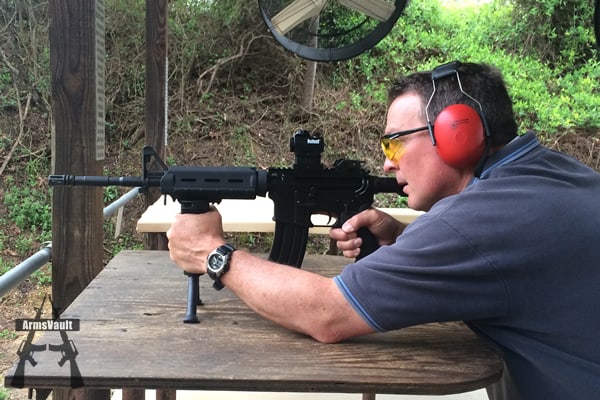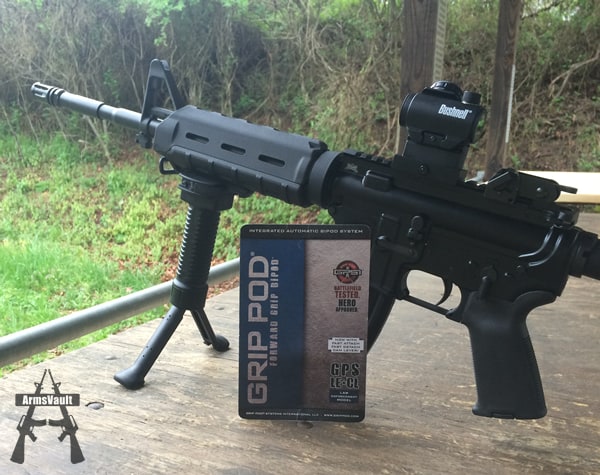Grip Pod Systems International, LLC’s Grip Pod Forward Grip BiPod
Model GPS LE*CL
Reviewed By: B.T. Davis
Grip Pod Systems International (GPSI), a Jacksonville Florida based manufacturer of vertical fore grip retractable bipod systems, has provided one of their polymer grip bipods for evaluation. The principals at GPSI created their first vertical fore grip bipod back in 2003 and formally established the company in 2005. Since then they’ve gone on to supply well in excess of 900,000 of their vertical fore grip bipods to the U.S. Dept. of Defense, other related U.S. Federal agencies, and the British Ministry of Defence. Over this time period they have been awarded thirty-one U.S. patents for the design features of their vertical fore grip retractable bipods.

The unit in question that we are working with is their excellent GPS LE*CL model. The abbreviation after the GPS name identifies it as their Law Enforcement/Cam Lever with quick-release functionality. Overall GPSI manufactures three different variations of their basic, proven design. The LE*CL model evaluated here, which features polymer bipod legs made of the same material as the fore grip. The other models that they offer are their Military model with more robust polymer coated, steel rod reinforced bipod legs, and their SAW model with forged aluminum bipod legs. The Military model’s bipod legs can support up to 300 lbs. of weight, and the SAW model’s forged aluminum legs can support over 300 lbs. of weight. In a dynamic combat situation where a combat gear laden user is running and dropping prone to deploy the bipod legs for a steadier shot the stiffer legs of the Military and the SAW models provide more robust and stable options under those conditions.
The GPS Law Enforcement/Cam Lever (LE*CL) model is perfect for supporting either AR platform carbines / rifles, or bolt action precision rifles commonly employed by law enforcement officers and civilian shooters today. The spring-loaded bipod legs are deployed by pushing a knurled button near the top front of the vertical grip with the user’s support hand index finger. Two legs then forcefully spring out the bottom of the grip body and angle outwards to give a sure-footed wide stance on which to rest the forward portion of the rifle. The legs spring out quite energetically in the blink of an eye. The spring mechanism driving the legs “gives” a little and the user can cant their rifle 10 degrees to either side as doing so will slightly compress the spring mechanism and allow the rifle to cant off to one side or the other. To retract the legs the user simply uses their support hand to forcefully push the legs upward, collapsing them together and locking them in place back up in the vertical grip body. The activation button requires a bit of deliberate force to activate, reducing the likelihood that inadvertently bumping it up against something in a dynamic environment would cause the bipod legs to accidentally deploy.

Additionally the unit is lightweight at 5-6 ounces and measures 5 ¾” retracted. With the legs extended it measures 8 ¼” and allows plenty of clearance hit the deck prone, or lay the rifle across the hood of a car, with a 30-round magazine seated in the well. The only requirement to mount the grip bipod to a rifle is that the rifle must have at least a 5”-6” long MIL-STD 1913 Picatinny rail attachment point on the underside of the forearm. For my evaluation I simply attached a MAGPUL rail segment to the underside of my rifle’s Magpul MOE forearm by which to mount the GPS LE*CL grip bipod.
Readers familiar with today’s profusion of cam locking, quick detach mechanisms for mounting AR platform optics on upper receiver Picatinny rails will instantly understand how to manipulate the GPS LE*CL unit’s quick release lever to either mount or dismount the grip. The cam locking mechanism is first adjusted to the correct width by loosening a hex head nut in the side of the mechanism which has a threaded bolt through it and which is affixed to the cam lock lever. Adjusting the nut and rotating it such that it securely recesses down into a hexagonal slot on the side of the mounting plate opposite the cam lock lever allows the cam lock lever to be opened, the opposite side of the grip bipod unit’s mounting plate to be clipped onto Picatinny mounting rail, and the lever side of the mounting plate to be rotated into place and the lever locked down flush – thus securely affixing the grip bipod to the rifle forearm. Unlatching it to either remove the unit or to slide it forward / backward for adjustment is as simple as unlatching the cam lock lever and removing / sliding the unit as necessary.

In use at the range either prone, or across shooting benches, the grip bipod proved to a welcome accessory to my rifle. It’s weight is essentially negligible at a few ounces, it provides a positive gripping and control option for the front handguard of my rifle, and when the bipod is deployed lightning fast either prone on the deck or across a bench / car hood it provides a rock-solid, stable support for precise sight alignment and target engagement. As mentioned above the height of the unit’s deployed legs is appropriate for running 30-round magazines with plenty of clearance.
The GPS LE*CL is available in either black or desert tan to match the furniture on your rifle. At present they can be sourced from a number of reputable online retailers of shooting accessories such as Brownells, U.S. Tactical Supply, Military Warfighter Solutions, Mounting Solutions Plus, and Holster Ops. Relative to the competition they are priced toward the middle and upper end of the range, but in terms of features, quality, selection, and an unassailable combat track record they are among the best.

As such, it is easy to see why Grip Pod Systems International have sold nearly a million of them to U.S. and allied operators who are in harm’s way on a daily basis. I highly recommend this product if you are in the market for a highly functional vertical fore grip that provides double duty as a solid bipod as well.
The full line of Grip Pod products can be seen at www.grippod.com.
The Grip Pod tested was sourced via Mounting Solutions Plus.

